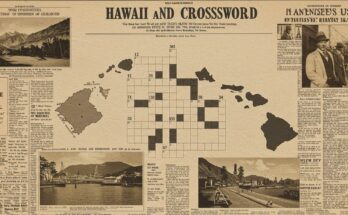An Introduction to the NYT Crossword
Are you ready to unlock the secrets of the New York Times crossword puzzle? If you’ve ever stared at a clue and felt like you’re gazing at an impenetrable vault, you’re not alone. The NYT Crossword is a beloved challenge for many, combining wit, knowledge, and a sprinkle of wordplay. Among its myriad clues lies one that stands out: the elusive “vault opener.” This particular clue can leave even seasoned solvers scratching their heads. But fear not! We’re here to guide you through this intriguing puzzle world. Whether you’re just starting or looking to sharpen your skills, understanding how to tackle these tricky clues will elevate your crossword game to new heights. Let’s dive in!
Understanding the Vault Opener Clue
The “Vault Opener” clue in the NYT Crossword can be a real brain teaser. It often refers to something or someone that unlocks potential or reveals hidden treasures.
Think of it as a metaphor for discovery. The clues may point towards famous figures, historical events, or even literary references related to unlocking secrets.
Context is key. Analyze surrounding answers and letters already filled in. This will guide your thought process and help you connect dots more easily.
Also, don’t shy away from synonyms. Words like “key,” “access,” and “reveal” might resonate with what you’re looking for when tackling this type of clue.
Keep an open mind; these clues can sometimes lead you down unexpected paths where creativity shines brighter than logic alone.
Tips and Tricks for Solving Crossword Clues
Crossword puzzles can be tricky, but a few tips and tricks can enhance your solving experience. Start by scanning the entire grid first. This gives you an overview of potential answers.
Focusing on fill-in-the-blank clues is often easier than others. These straightforward hints usually lead to quicker successes.
Consider common letter patterns too; words like “the,” “and,” or “is” frequently pop up in various contexts.
When you’re stuck, don’t hesitate to work backward. If you have some letters filled in already, think about what words fit those spaces.
Don’t shy away from using online resources for definitions or synonyms when needed. It’s all part of honing your skills!
Practice regularly—your speed and confidence will grow with time as you become familiar with recurring themes and wordplay styles.
Decoding the Vault Opener Clue: Step by Step Instructions
Decoding the Vault Opener clue can feel like a puzzle within a puzzle. Start by examining the length of the answer. This gives you crucial information about how many letters you’ll need.
Next, look for any crossing words that provide hints. Often, letters from other answers will help clarify your options.
Keep an eye out for common abbreviations or slang that might serve as clues. The NYT Crossword often plays on language in clever ways.
Think outside the box too; sometimes, “vault opener” could refer to something metaphorical rather than literal—like a key or combination.
If you’re stuck, don’t hesitate to consult crossword resources online. They can offer insights into recurring themes and phrases used in these puzzles, making it easier to spot patterns in future clues.
Other Commonly Used Clues in the NYT Crossword
The NYT Crossword features a variety of clues that challenge solvers daily. Some are straightforward, while others require lateral thinking.
One common clue involves puns or wordplay. Clues like “Spooner’s take on ‘It’s time for bed’” might hint at something unexpected yet familiar.
Abbreviations frequently make an appearance too. They can reference anything from U.
S. states to popular organizations, so it’s essential to keep those acronyms in mind.
Cultural references also pop up often, including celebrities or iconic movies. A clue such as “Actor with the famous line ‘I’ll have what she’s having’” could lead you straight to Meg Ryan.
Historical and geographical hints appear regularly, testing your knowledge beyond just current events. Be prepared for questions about landmarks or significant events throughout history—these keep the puzzles fresh and engaging!
Practice Makes Perfect: Solving Sample Puzzles
Practice is essential when it comes to mastering the NYT Crossword. The more you engage with puzzles, the better your skills will become.
Begin by allocating a short period of time every day for practice. Choose puzzles that challenge you but are still within your grasp. This balance helps build confidence and enhances problem-solving abilities.
Consider using themed or archived crosswords from previous weeks or even months. They often contain clues similar to what you’ll encounter in current editions, making them great practice material.
Don’t shy away from sharing your progress with friends or joining online groups focused on crossword solving. Discussing strategies can provide fresh insights and enhance learning experiences.
Keep track of difficult clues you’ve encountered previously. Revisiting these can help reinforce your memory and boost clarity when similar ones pop up again in future puzzles.
Conclusion
Solving crossword puzzles can be an exhilarating journey, especially when you encounter intriguing clues like the vault opener in the NYT Crossword. By understanding how to approach these clues and employing strategies that work best for you, tackling even the most challenging entries becomes manageable.
The next time you find yourself staring at a vault opener clue, remember to think outside the box. Use your knowledge of common crossword themes, consider context clues from intersecting answers, and don’t hesitate to explore online resources or communities dedicated to crosswords.
With practice and patience, you’ll unlock not just individual puzzles but also enhance your overall puzzle-solving skills. Keep challenging yourself with diverse crossword puzzles—there’s always something new waiting behind those clever cues!



